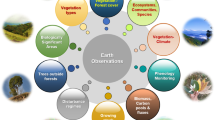Abstract
The recent and rapid advancements of digital technologies, as well as the progress of digital cameras and other various connected objects have resulted in a great increase of multimedia data production worldwide. Such data becomes more and more crucial for understanding environmental issues and phenomena, such as the greenhouse effect, global warming and biodiversity loss. Therefore, there is an increasing need for the development of advanced methods, techniques and tools for collecting, managing, analyzing and understanding environmental and biodiversity data. The goal of this introductory chapter is to give a global picture of that domain and to overview the research works presented in this book.
Access this chapter
Tax calculation will be finalised at checkout
Purchases are for personal use only
Similar content being viewed by others
References
Wiggins, S. (2003). Autonomous acoustic recording packages (ARPs) for long-term monitoring of whale sounds. Marine Technology Society Journal, 37(2), 13–22.
Fox, C. G., Matsumoto, H., & Lau, T. K. A. (2001). Monitoring Pacific Ocean seismicity from an autonomous hydrophone array. Journal of Geophysical Research: Solid Earth, 106(B3), 4183–4206.
Beaman, R. S., & Cellinese, N. (2012). Mass digitization of scientific collections: New opportunities to transform the use of biological specimens and underwrite biodiversity science. ZooKeys, (209), 7.
Fisher, R.B., Chen-Burger, Y.H., Giordano, D., Hardman, L., Lin, F.P.: Fish4Knowledge: Collecting and Analyzing Massive Coral Reef Fish Video Data, vol. 104. Springer (2016)
Nagai, S., Maeda, T., Gamo, M., Muraoka, H., Suzuki, R., Nasahara, K.N.: Using digital camera images to detect canopy condition of deciduous broad-leaved trees. Plant Ecology & Diversity 4(1), 79–89 (2011)
Silver, S.C., Ostro, L.E., Marsh, L.K., Maffei, L., Noss, A.J., Kelly, M.J., Wallace, R.B., Gómez, H., Ayala, G.: The use of camera traps for estimating jaguar panthera onca abundance and density using capture/recapture analysis. Oryx 38(2), 148–154 (2004)
Author information
Authors and Affiliations
Corresponding author
Editor information
Editors and Affiliations
Rights and permissions
Copyright information
© 2018 Springer International Publishing AG, part of Springer Nature
About this chapter
Cite this chapter
Joly, A., Bonnet, P., Vrochidis, S., Karatzas, K., Karppinen, A. (2018). Introduction. In: Joly, A., Vrochidis, S., Karatzas, K., Karppinen, A., Bonnet, P. (eds) Multimedia Tools and Applications for Environmental & Biodiversity Informatics. Multimedia Systems and Applications. Springer, Cham. https://doi.org/10.1007/978-3-319-76445-0_1
Download citation
DOI: https://doi.org/10.1007/978-3-319-76445-0_1
Published:
Publisher Name: Springer, Cham
Print ISBN: 978-3-319-76444-3
Online ISBN: 978-3-319-76445-0
eBook Packages: Computer ScienceComputer Science (R0)




